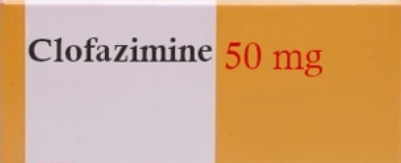
Indications
- Lepromatous leprosy.
- Multibacillary leprosy (in combination with rifampicin and dapsone).
- Erythema nodosum leprosum.
- Chronic discoid lupus erythematosus
- Granulomatous cheilitis
- Chronic graft-versus-host disease.
- Neutrophilic dermatoses (pyoderma gangrenosum, Sweet syndrome) .
- Granuloma faciale.
- Orofacial granulomatosis.
- Granulomatous cheilitis.
- Ashy dermatosis.
- Acne fulminans.
- keloidal blastomycosis.
- Other infections : (mycobacterial, malacoplakia, rhinoscleroma).
Dosage
- 50–400 mg orally daily(Larger doses are usually divided into two to four times daily).
- Multibacillary leprosy. : Clofazimine 300 mg (Monthly supervised) + Clofazimine 50 mg (daily self‐administered) for 12 months.
- Erythema nodosum leprosum. : Clofazimine 300 mg/day for several months.
- Ashy dermatosis: Clofazimine 100 mg/day for 3 months in inflammatory cases.
- Acne fulminans: Clofazimine 200 mg three times a week.
- Orofacial granulomatosis: Clofazimine 100 mg twice daily 10 days, then twice weekly for 4 months.
- Granulomatous cheilitis: Clofazimine 100 mg twice daily for 10 days, then twice weekly for 4 months.
- keloidal blastomycosis: combination of itraconazole,100 mg/day, and clofazimine, 100 mg/day. .
- Granuloma faciale: Clofazimine (300 mg daily).
- pyoderma gangrenosum: Clofazimine 100 mg three times daily( 4 weeks).
- Sweet syndrome: Clofazimine 200 mg/day for 4 weeks followed by 100 mg/day for 4 weeks.
Mechanism of action
- Antimycobacterial -Anti-inflammatory-Selective immunomodulation.
- Clofazimine binds to mycobacterial DNA leading to disruption of the cell cycle and eventually kills the bacterium.
- It disrupts cell membranes and inhibits bacterial proliferation (activation of phospholipase A2 leads to generation of membrane-destabilizing lysophospholipids).
- Clofazimine enhances superoxide production .
- It inhibits neutrophil motility and lymphocyte proliferation.
Monitoring
Baseline Monitoring
- Baseline electrolyte panel.
Follow Up Monitoring
- Periodic LFTs if daily doses >100 mg.
- Periodic evaluation for GI side effects and skin discoloration.
Side effects
- Reversible orange-brown discoloration of the skin.
- Discoloration of cornea, conjunctiva, and body fluids (urine, sweat, tears).
- Xerosis, ichthyosis.
- Gastrointestinal symptoms:(abdominal pain, nausea, vomiting, diarrhea)
- Ocular irritation.
- Elevated hepatic enzymes.
- Fatal enteropathy (rarely).
- Cardiac arrhythmias (rarely; associated with electrolyte disturbances).
- Exacerbation of vitiligo.
- Depression secondary to skin discoloration.
Contraindications
- Prior hypersensitivity reaction.
Interactions
- A degree of caution is encouraged for concomitant use with either rifampin or isoniazid.
- Dapsone may inhibit the anti-inflammatory activity of clofazimine( have not been confirmed).
- Clofazimine and deutetrabenazine both increase QTc interval. Avoid or Use Alternate Drug.
- Ivosidenib and clofazimine both increase QTc interval. Avoid or Use Alternate Drug.
- Macimorelin and clofazimine both increase QTc interval. Avoid or Use Alternate Drug.
- Ribociclib and clofazimine both increase QTc interval. Avoid or Use Alternate Drug.
- Clofazimine and gemtuzumab both increase QTc interval. Use Caution/Monitor.
- Clofazimine and lofexidine both increase QTc interval. Use Caution/Monitor. ECG monitoring is recommended.
- Oxaliplatin will increase the level or effect of clofazimine. Use Caution/Monitor.
- Monitor for ECG changes if therapy is initiated in patients with drugs known to prolong QT.
- Clofazimine decreases levels of rifampin by inhibition of GI absorption. Applies only to oral form of both agents.
Pregnancy & Lactation
- Clofazimine should be avoided during pregnancy (formerly category C)
- Lactation (concentrated in breast milk).
- Breast milk may turn pink and nursing infants of mothers taking clofazimine have developed skin discolouration.
Precautions
- Avoid long-term administration of >200 mg daily.
- Clofazimine should be used with caution in patients who have gastrointestinal problems such as abdominal pain and diarrhea.
- Severe abdominal symptoms have necessitated exploratory laparotomies in some patients receiving clofazimine.
- For skin dryness and ichthyosis, oil can be applied to the skin.
- Discoloration of soft contact lenses may also occur.
Drug Info
- The pigmentation usually fades within 6–12 months of stopping clofazimine, although traces of discoloration may remain for up to 4 years.
- When taken with food, absorption is increased.
- Patients should be warned that clofazimine may cause a discoloration of the skin from red to brownish-black, as well as discoloration of the conjunctivae, lacrimal fluid, sweat, sputum, urine, and feces.
#Clofazimine #Clofazimine dosage in dermatology #Clofazimine dose in leprosy #Clofazimine in dermatology #Clofazimine indications